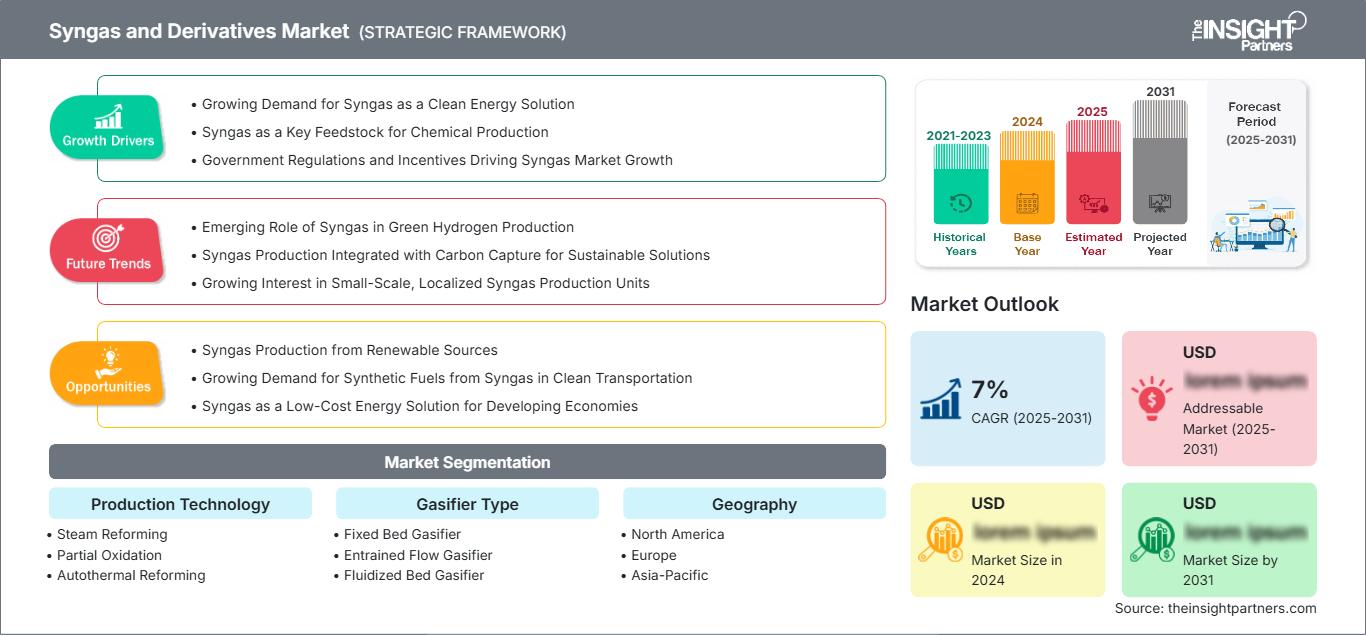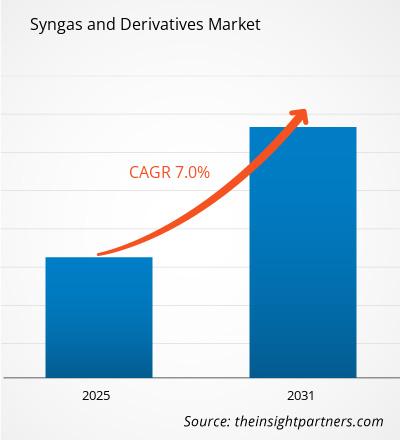合成ガスおよび誘導体市場は、2025年から2031年にかけて年平均成長率7%で成長し、市場規模は2024年のXX百万米ドルから2031年にはXX百万米ドルに拡大すると予想されています。
合成ガスおよび誘導体市場は、生産技術(水蒸気改質、部分酸化、自己熱改質、バイオマスガス化、その他)、ガス化炉の種類(固定(移動)床ガス化炉、噴流床ガス化炉、流動床ガス化炉、その他)、原料(石炭、天然ガス、石油副産物、バイオマスまたは廃棄物、その他)、用途(化学物質、燃料、電力)、および地域(北米、ヨーロッパ、アジア太平洋、中東およびアフリカ、南米および中米)別の分析をカバーしています。合成ガスは、水素、一酸化炭素、そしてある程度の二酸化炭素の混合物である燃料ガスとして定義されています。混合物とその結果生じるガス化により、基本的に燃料として、電力やその他の化学物質の製造に利用できる合成ガスが生成されます。
レポートの目的
The Insight Partners によるレポート「合成ガスおよび誘導体市場」は、現在の状況と将来の成長、主な推進要因、課題、および機会について説明することを目的としています。これにより、次のようなさまざまなビジネス関係者に洞察が提供されます。
- 技術プロバイダー/メーカー: 進化する市場動向を理解し、潜在的な成長機会を把握することで、情報に基づいた戦略的決定を下すことができます。
- 投資家: 市場の成長率、市場の財務予測、およびバリュー チェーン全体に存在する機会に関する包括的なトレンド分析を実施します。
- 規制機関: 市場の乱用を最小限に抑え、投資家の信頼と信用を維持し、市場の完全性と安定性を維持することを目的として、市場における政策と警察活動を規制します。
合成ガスおよび誘導体市場の細分化:生産技術
- 水蒸気改質
- 部分酸化
- オートサーマル改質
- バイオマスガス化
ガス化炉の種類
- 固定床ガス化炉
- 噴流床ガス化炉
- 流動床ガス化炉
レポートの一部、国レベルの分析、Excelデータパックなどを含め、スタートアップ&大学向けに特別オファーや割引もご利用いただけます(無償)
合成ガスおよび誘導体市場: 戦略的洞察

- このレポートの主要な市場動向を入手してください。この無料サンプルには、市場動向から見積もりや予測に至るまでのデータ分析が含まれます。
合成ガスおよび誘導体市場の成長要因
- クリーンエネルギーソリューションとしての合成ガス需要の高まり:よりクリーンなエネルギー源に対する世界的な需要の高まりにより、合成ガスは興味深く多用途なエネルギーソリューションとなっています。発電における代替燃料として、合成ガスは天然ガス、石炭、またはバイオマスの副産物であり、低炭素エネルギーシステムへの移行において重要な役割を果たしています。
- 化学品製造の主要原料としての合成ガス:合成ガスは、アンモニア、メタノール、合成燃料などの化学物質の製造における重要な原料です。農業、自動車、建設などの業界における化学物質の需要の増加は、多くの重要な化合物の効率的な前駆物質であるため、合成ガスの需要を押し上げ続けています。
- 合成ガス市場の成長を促進する政府の規制とインセンティブ:各国政府は、より厳しい環境規制を導入し、よりクリーンなエネルギー生産に対するインセンティブを提供しています。炭素回収・貯留などの合成ガス製造技術は、炭素排出量を削減できるため、市場における需要増加の理由となります。
合成ガスおよび誘導体市場の将来の動向
- グリーン水素製造における合成ガスの新たな役割:グリーン水素製造の前駆体としての合成ガス開発が台頭しています。再生可能エネルギー源を使用したガス化プロセスは、合成ガスを水素に変換することができ、これは将来の市場成長を牽引する輸送や重工業などの分野にとって重要となります。
- 持続可能なソリューションのための炭素回収と統合された合成ガス製造:合成ガス製造と炭素回収、利用、貯留技術の統合はますます重要になっています。これは、将来、合成ガス生産によって排出量が削減される傾向があり、気候変動を緩和したい産業にとって、より持続可能なソリューションとなるためです。
- 小規模で地域に密着した合成ガス生産ユニットへの関心の高まり:小規模な合成ガス生産ユニットは、バイオマスや廃棄物から地域的に生産できます。エネルギー生成の分散化と分配システムにより、大規模な集中型システムではなく小規模な施設への関心が高まり、エネルギー安全保障が向上しています。
合成ガスおよび派生製品の市場機会
- 再生可能エネルギー源からの合成ガス生産:バイオマスや廃棄物発電技術などの再生可能エネルギー源からの合成ガス生産は、大きな成長の機会を表しています。これにより、持続可能なカーボンニュートラルなエネルギーの供給量が増加し、廃棄物の抑制と資源回収にも役立ちます。
- クリーン輸送における合成ガスからの合成燃料の需要増加:合成ガスからの合成燃料の生産には、SNGと合成ガソリンが含まれます。よりクリーンな代替燃料源の需要が高まっているため、これはますます大きなチャンスです。持続可能な輸送ソリューションとカーボンニュートラルな燃料源への関心が高まるにつれて、需要は増加すると予想されます。
- 発展途上国向けの低コストエネルギーソリューションとしての合成ガス:合成ガスとその派生物は、急速に工業化が進み、エネルギー需要が増加している発展途上国において、低コストのエネルギー生成と化学製品生産の源として機能します。アジア太平洋地域とアフリカ市場における合成ガスベースの技術とインフラ開発には、大きな成長の機会があります。
合成ガスおよび誘導体市場
The Insight Partnersのアナリストは、予測期間全体を通して合成ガスおよび誘導体市場に影響を与える地域的な傾向と要因を詳細に解説しています。このセクションでは、北米、ヨーロッパ、アジア太平洋、中東・アフリカ、中南米における合成ガスおよび誘導体市場のセグメントと地域についても解説します。
合成ガスおよび誘導体市場レポートの範囲
| レポート属性 | 詳細 |
|---|---|
| の市場規模 2024 | US$ XX million |
| 市場規模別 2031 | US$ XX Million |
| 世界的なCAGR (2025 - 2031) | 7% |
| 過去データ | 2021-2023 |
| 予測期間 | 2025-2031 |
| 対象セグメント |
By 生産技術
|
| 対象地域と国 | 北米
|
| 市場リーダーと主要企業の概要 |
|
合成ガスおよび派生製品の市場プレーヤーの密度:ビジネスダイナミクスへの影響を理解する
合成ガスおよび誘導体市場は、消費者の嗜好の変化、技術の進歩、製品の利点に対する認知度の高まりといった要因によるエンドユーザーの需要増加に牽引され、急速に成長しています。需要の増加に伴い、企業は製品ラインナップの拡充、消費者ニーズへの対応のためのイノベーション、そして新たなトレンドの活用を進めており、これが市場の成長をさらに加速させています。

- 入手 合成ガスおよび誘導体市場 主要プレーヤーの概要
主なセールスポイント
- 包括的な調査範囲:本レポートは、合成ガスおよび誘導体市場における製品、サービス、タイプ、エンドユーザーの分析を包括的に網羅し、包括的な展望を提供しています。
- 専門家による分析:本レポートは、業界の専門家とアナリストの深い理解に基づいて作成されています。
- 最新情報:本レポートは、最新の情報とデータ動向を網羅しているため、ビジネスの関連性を保証します。
- カスタマイズオプション:本レポートは、特定のクライアントの要件に対応し、ビジネス戦略に適切に適合するようにカスタマイズできます。
したがって、合成ガスおよび誘導体市場に関する調査レポートは、業界のシナリオと成長見通しを解読し理解するための先導役となります。いくつかの正当な懸念事項があるかもしれませんが、本レポートの全体的なメリットは、デメリットを上回る傾向があります。
- 過去2年間の分析、基準年、CAGRによる予測(7年間)
- PEST分析とSWOT分析
- 市場規模価値/数量 - 世界、地域、国
- 業界と競争環境
- Excel データセット
最新レポート
関連レポート
お客様の声
購入理由
- 情報に基づいた意思決定
- 市場動向の理解
- 競合分析
- 顧客インサイト
- 市場予測
- リスク軽減
- 戦略計画
- 投資の正当性
- 新興市場の特定
- マーケティング戦略の強化
- 業務効率の向上
- 規制動向への対応




















 無料サンプルを入手 - 合成ガスおよび誘導体市場
無料サンプルを入手 - 合成ガスおよび誘導体市場